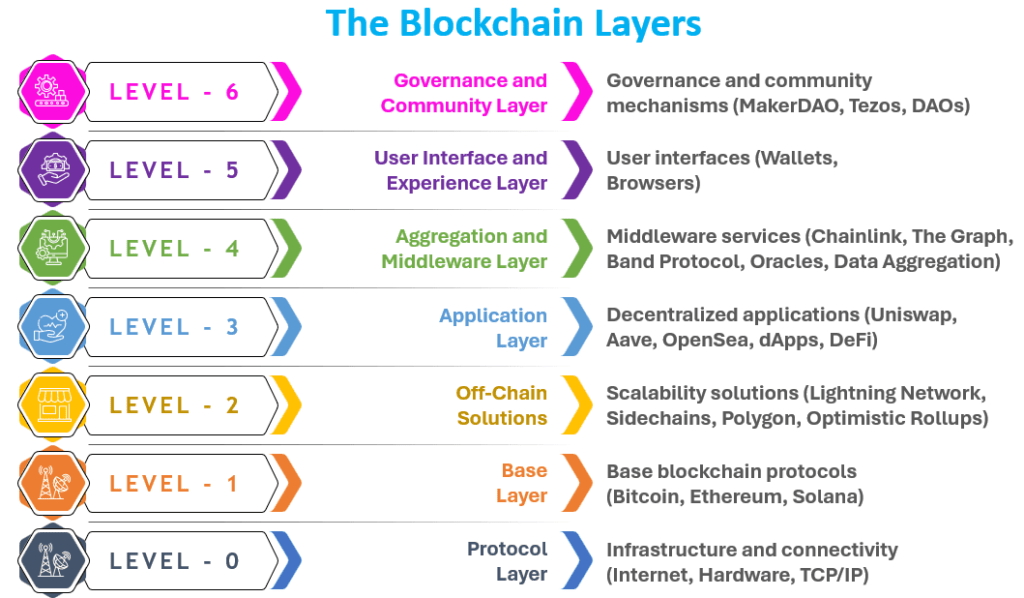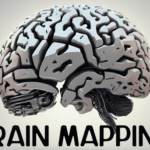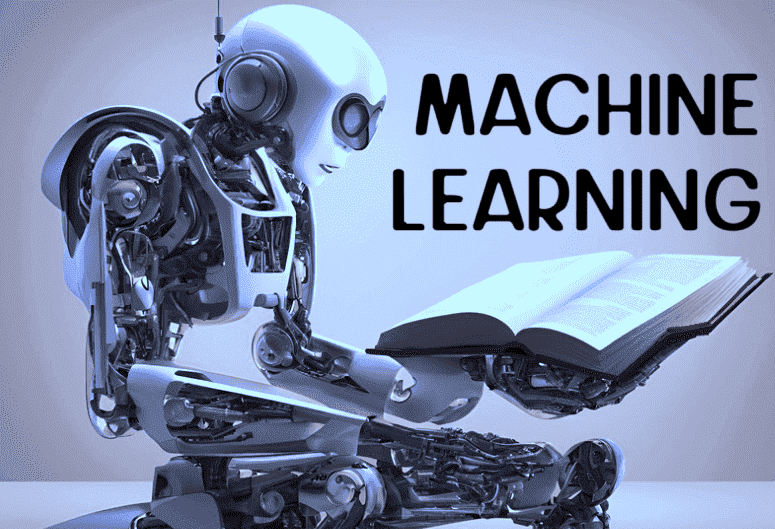
Overview:
Blockchain technology, often heralded as a revolutionary force in the digital era, comprises a complex and multi-layered architecture. Each blockchain layer within this architecture plays a distinct yet interconnected role, contributing to the overall functionality, scalability, and security of blockchain networks. From the foundational infrastructure to user interfaces and governance mechanisms, understanding the nuances of these layers is essential for anyone looking to navigate or innovate within the blockchain space.
At its core, blockchain is more than just a distributed ledger; it’s an intricate ecosystem where various layers interact to create a robust and efficient system. The foundational layers provide the necessary infrastructure and protocols, while upper layers build upon these to offer advanced functionalities and user experiences. This article delves into each of these architectural layers, exploring their specific roles, operations, and interdependencies. By examining how these layers work together, we can gain a deeper understanding of how blockchain technology achieves its revolutionary potential and addresses the challenges of the digital age.
In the following sections, we will break down each layer, starting from the basic infrastructure (Layer 0) to the governance and community engagement (Layer 6). This comprehensive exploration will reveal how each layer not only supports the ones above it but also how they collectively enhance the capabilities and applications of blockchain technology. Whether you’re a developer, investor, or enthusiast, this detailed overview will provide valuable insights into the foundational structure of blockchain and its multifaceted operations.
So, let’s understand what blockchain layers are through this in-depth view, along with examples of each layer:

1. Layer 0 (Protocol Layer):
Layer 0 is the foundational infrastructure that supports blockchain networks. This includes the physical and network infrastructure necessary for the blockchain to function. It encompasses the internet, hardware, and communication protocols that facilitate the operation of blockchain nodes and data transmission across the network.
Operation:
Networking: Nodes communicate via protocols like TCP/IP, ensuring data transmission across the network.
Hardware: Computers and servers run blockchain nodes, maintaining the network and processing transactions.
Protocols: Define rules for node interaction, data validation, and network security.
Examples:
Internet and Network Infrastructure: The global internet, data centers, and network connections that support the operation of blockchain nodes.
Hardware: Computers, servers, and specialized mining equipment (such as ASICs for Bitcoin mining) that run blockchain nodes.
Communication Protocols: TCP/IP, which underpins data transmission over the internet, and other networking protocols that ensure reliable connectivity between nodes.
2. Layer 1 (Base Layer):
Layer 1 refers to the core blockchain architecture, comprising the main blockchain protocol. It includes the consensus mechanisms, data structures, and base functionalities necessary for the blockchain to operate. Layer 1 is responsible for ensuring security, data integrity, and transaction processing.
Operation:
Consensus Mechanism: Determines how nodes agree on the state of the blockchain (e.g., Proof of Work, Proof of Stake).
Transaction Validation: Nodes validate transactions, ensuring they adhere to protocol rules and are legitimate.
State Management: Maintains an immutable ledger of transactions, updating the blockchain state with each validated block.
Examples:
Bitcoin (BTC): Utilizes Proof of Work (PoW) to secure the network and process transactions.
Ethereum (ETH): Transitioning from PoW to Proof of Stake (PoS) with Ethereum 2.0, enabling smart contracts and decentralized applications.
Solana (SOL): Combines Proof of History (PoH) with PoS to achieve high throughput and low latency.
3. Layer 2 (Off-Chain Solutions):
Layer 2 solutions are built on top of Layer 1 to enhance scalability and performance by handling transactions off the main blockchain. These solutions reduce the load on the base layer, enabling faster and cheaper transactions while maintaining security and decentralization.
Operation:
Payment Channels: Two parties can conduct multiple transactions off-chain, settling only the final state on-chain to reduce transaction costs and latency.
Sidechains: Separate blockchains that process transactions independently, periodically reconciling with the main chain for security and data integrity.
Rollups: Aggregate transactions off-chain, verifying validity before submitting them as a batch to the main chain, optimizing throughput and scalability.
Examples:
Lightning Network (Bitcoin): An off-chain network that facilitates instant, low-cost transactions between participants by creating payment channels.
Polygon (formerly Matic Network): A sidechain and scaling solution for Ethereum, providing faster and cheaper transactions through a network of interconnected chains.
Optimistic Rollups (Ethereum): A Layer 2 solution that aggregates multiple transactions off-chain and posts them on-chain in batches, reducing congestion and fees.
4. Layer 3 (Application Layer):
Layer 3 consists of decentralized applications (dApps) and protocols built on top of blockchain networks. These applications leverage the underlying layers for security, consensus, and data integrity while providing user-facing functionalities and services.
Operation:
Smart Contracts: Self-executing contracts stored on the blockchain, automating predefined conditions and transactions without intermediaries.
Decentralized Exchanges (DEX): Platforms enabling peer-to-peer trading of digital assets, utilizing smart contracts for trustless transactions.
Decentralized Finance (DeFi) Apps: Offer financial services like lending, borrowing, and staking directly on the blockchain, often using automated protocols.
Examples:
Uniswap: A decentralized exchange (DEX) on Ethereum for swapping ERC-20 tokens without the need for intermediaries.
Aave: A decentralized lending and borrowing platform allowing users to lend, borrow, and earn interest on cryptocurrency assets.
OpenSea: A marketplace for creating, buying, selling, and trading non-fungible tokens (NFTs).
5. Layer 4 (Aggregation and Middleware Layer):
Layer 4 includes services and protocols that provide additional functionality to dApps by integrating external data and enabling interoperability between different blockchains. These components enhance the capabilities of dApps and ensure they can interact with real-world data and other blockchain ecosystems.
Operation:
Oracles: Fetch data from external sources (e.g., APIs, IoT devices) and feed it to smart contracts on the blockchain for decision-making.
Indexing Services: Provide efficient data querying and retrieval from the blockchain, enabling faster application performance and data analytics.
Cross-Chain Communication: Facilitate asset transfers and data exchange between different blockchain networks, promoting interoperability and expanding use cases.
Examples:
Chainlink: A decentralized oracle network that provides real-world data to smart contracts, enabling them to interact with external systems and APIs.
The Graph: A decentralized indexing protocol that allows for efficient querying and retrieval of blockchain data, facilitating the development of dApps.
Band Protocol: Another oracle service that aggregates and connects real-world data with smart contracts.
6. Layer 5 (User Interface and Experience Layer):
Layer 5 encompasses the user-facing components that allow individuals to interact with blockchain networks and applications. This includes wallets, browsers, and other interfaces that simplify the user experience and facilitate access to blockchain services.
Operation:
Wallets: Software applications enabling users to store, manage, and transfer cryptocurrencies and tokens securely.
Browser Extensions: Integrates blockchain functionalities directly into web browsers, enabling seamless interaction with dApps.
User Interfaces (UI): Design and development of user-friendly interfaces that simplify complex blockchain interactions, enhancing accessibility and adoption.
Examples:
MetaMask: A popular Ethereum wallet and browser extension that enables users to interact with dApps directly from their browser.
Trust Wallet: A mobile wallet that supports multiple cryptocurrencies and dApps, providing a user-friendly interface for managing digital assets.
Brave Browser: A web browser with integrated blockchain and cryptocurrency features, such as the Basic Attention Token (BAT) rewards program.
7. Layer 6 (Governance and Community Layer):
Layer 6 involves the governance mechanisms and community frameworks that oversee the development, maintenance, and evolution of blockchain protocols and applications. This includes on-chain governance models, voting systems, and community-driven initiatives that ensure decentralized and transparent decision-making.
Operation:
On-Chain Governance: Allows token holders or validators to propose and vote on protocol upgrades, changes, and funding allocations directly on the blockchain.
Decentralized Autonomous Organizations (DAOs): Organizations governed by smart contracts, enabling collective decision-making and resource allocation through token holder voting.
Community Initiatives: Engage developers, users, and stakeholders in collaborative efforts to improve and innovate blockchain protocols, fostering community-driven development.
Examples:
MakerDAO: A decentralized organization that manages the DAI stablecoin and uses on-chain governance for protocol updates and risk management decisions.
Tezos: A blockchain with a self-amending on-chain governance model, allowing stakeholders to vote on protocol upgrades and changes.
Decentralized Autonomous Organizations (DAOs): Organizations like Aragon and MolochDAO that enable decentralized governance and community-driven decision-making for various projects and protocols.
Now, let’s examine the interdependencies among blockchain architectural layers:
1. Layer 0 (Protocol Layer) and Layer 1 (Base Layer):
Dependency: Layer 1 relies on Layer 0 for foundational infrastructure such as internet connectivity, hardware resources (nodes), and communication protocols (TCP/IP).
Interplay: Nodes in Layer 1 use Layer 0 infrastructure to communicate, validate transactions, and propagate blocks across the network.
Example: Bitcoin miners (Layer 1) depend on stable internet connectivity and robust hardware (Layer 0) to participate in the Proof of Work (PoW) consensus mechanism.
2. Layer 1 (Base Layer) and Layer 2 (Off-Chain Solutions):
Dependency: Layer 2 solutions often build upon Layer 1’s transaction validation and state management capabilities.
Interplay: Layer 2 solutions relieve congestion on Layer 1 by handling transactions off-chain, improving scalability and reducing transaction costs.
Example: The Lightning Network (Layer 2) for Bitcoin enables fast and inexpensive microtransactions by leveraging Bitcoin’s base layer security and settlement guarantees.
3. Layer 2 (Off-Chain Solutions) and Layer 3 (Application Layer):
Dependency: Layer 3 dApps utilize Layer 2 for efficient transaction processing and scalability.
Interplay: Layer 2 solutions support Layer 3 dApps by providing faster transaction throughput and reduced latency, enhancing user experience.
Example: DeFi protocols (Layer 3) like decentralized exchanges (DEXs) benefit from Layer 2 scaling solutions to handle high transaction volumes without congesting the main blockchain.
4. Layer 3 (Application Layer) and Layer 4 (Aggregation and Middleware Layer):
Dependency: Layer 4 integrates external data into Layer 3 dApps via oracles and indexing services.
Interplay: Layer 3 dApps rely on Layer 4 for real-world data inputs and interoperability with other blockchain networks, enhancing functionality and usability.
Example: Decentralized finance (DeFi) platforms (Layer 3) use oracles (Layer 4) to fetch price feeds for asset valuation and smart contract execution.
5. Layer 4 (Aggregation and Middleware Layer) and Layer 5 (User Interface and Experience Layer):
Dependency: Layer 5 interfaces rely on Layer 4 for data aggregation and secure data transmission.
Interplay: Layer 4 provides data services and cross-chain capabilities that Layer 5 interfaces utilize to offer users seamless and intuitive interactions with blockchain applications.
Example: Wallets and dApp browsers (Layer 5) integrate with indexing protocols (Layer 4) to provide users with real-time blockchain data and analytics.
6. Layer 5 (User Interface and Experience Layer) and Layer 6 (Governance and Community Layer):
Dependency: Layer 6 governance mechanisms influence the development and adoption of Layer 5 user interfaces.
Interplay: Layer 5 interfaces facilitate user engagement and participation in Layer 6 governance processes, fostering decentralized decision-making and community involvement.
Example: Wallets and dApp browsers (Layer 5) may integrate governance features (Layer 6) that allow token holders to vote on protocol upgrades directly from their interfaces.
Before concluding, let’s also explore the contexts and perspectives of the blockchain layers:
1. Technical Implementation Context:
In this context, the blockchain stack focuses on the technical aspects of building and implementing blockchain solutions. It encompasses the underlying technologies, protocols, and components required to develop and deploy blockchain systems.
Examples:
Smart Contract Development: Tools and languages like Solidity (for Ethereum), Rust (for Solana), and Vyper.
Blockchain Frameworks: Platforms like Hyperledger Fabric, Corda, and Quorum that provide the infrastructure for creating custom blockchain networks.
2. Economic and Incentive Structure Context:
The blockchain stack can also be analyzed in terms of the economic models and incentive structures that drive participation and security within the network. This includes mechanisms for token distribution, mining/staking rewards, and economic incentives for developers and users.
Examples:
Cryptocurrency Incentives: Bitcoin mining rewards, Ethereum gas fees.
Staking Models: Rewards for staking tokens in networks like Ethereum 2.0, Tezos, and Cardano.
Governance Tokens: Tokens that grant voting rights and influence over protocol decisions, such as MakerDAO’s MKR or Uniswap’s UNI.
3. Regulatory and Compliance Context:
Understanding the blockchain stack is crucial in navigating the regulatory and compliance landscape. This involves ensuring that blockchain applications adhere to legal requirements and standards, addressing issues like data privacy, financial regulations, and smart contract enforceability.
Examples:
Compliance Solutions: Chainalysis, Elliptic for transaction monitoring and compliance.
Regulatory Frameworks: GDPR compliance for blockchain applications in Europe, SEC regulations for token offerings in the US.
Legal Frameworks: Smart contracts’ legal enforceability and recognition in various jurisdictions.
4. Security and Trust Context:
The blockchain stack also addresses security concerns at each layer, from the underlying network protocols to the application level. This includes mechanisms to ensure data integrity, prevent fraud, and secure user interactions.
Examples:
Consensus Algorithms: Proof of Work (PoW), Proof of Stake (PoS), and Delegated Proof of Stake (DPoS) to secure the network.
Security Audits: Regular audits of smart contracts and blockchain code by firms like ConsenSys Diligence and CertiK.
Identity Solutions: Decentralized identity platforms like Sovrin and uPort.
5. Interoperability and Integration Context:
Another important context is the interoperability between different blockchain networks and integration with existing systems. This involves protocols and tools that enable seamless interaction and data exchange across multiple blockchains.
Examples:
Cross-Chain Solutions: Polkadot and Cosmos, which facilitate interoperability between different blockchains.
Interoperability Protocols: Atomic swaps, wrapped tokens (like Wrapped Bitcoin on Ethereum), and bridges (such as the Binance Smart Chain Bridge).
6. User Adoption and Experience Context:
Finally, the blockchain stack is relevant in the context of user adoption and experience. This involves creating intuitive and accessible interfaces that encourage widespread use of blockchain applications.
Examples:
User-Friendly Wallets: Wallets like MetaMask and Trust Wallet that provide easy access to blockchain services.
DApp Browsers: Platforms like Status and Brave Browser that integrate blockchain functionality into web browsing.
Educational Tools: Resources and platforms like CryptoZombies and Ethereum.org that educate users and developers about blockchain technology.
Summing Up:
Blockchain’s architectural layers form a complex yet interconnected ecosystem, each layer playing a crucial role in the functionality and advancement of decentralized technology. At the foundational Layer 0, infrastructure and protocols establish the backbone of blockchain networks, ensuring robust connectivity and data transmission. Layer 1 builds upon this foundation with core blockchain protocols, handling consensus mechanisms and transaction validations that secure and maintain the decentralized ledger.
Layer 2 introduces scalability solutions through off-chain processing, alleviating congestion on Layer 1 and enhancing transaction throughput. This scalability supports Layer 3 applications, where decentralized applications (dApps) thrive, offering innovative solutions like decentralized finance (DeFi) and smart contract functionalities. Layer 4 bridges external data integration and blockchain interoperability, utilizing oracles and indexing services to enrich dApps with real-world information and facilitate seamless interaction across multiple blockchains.
Layer 5 focuses on user interaction, providing intuitive interfaces and wallets that simplify access to blockchain applications for broader adoption. Lastly, Layer 6 introduces governance frameworks that empower community-driven decision-making, ensuring decentralized control over protocol upgrades and ecosystem development.
Together, these layers form a comprehensive blockchain ecosystem where infrastructure, protocol, scalability, application, user interface, data integration, and governance interact harmoniously to propel the evolution of decentralized technology. Understanding these interdependencies is pivotal for stakeholders navigating the complexities of blockchain development, fostering innovation, and harnessing the full potential of blockchain across industries and use cases.











